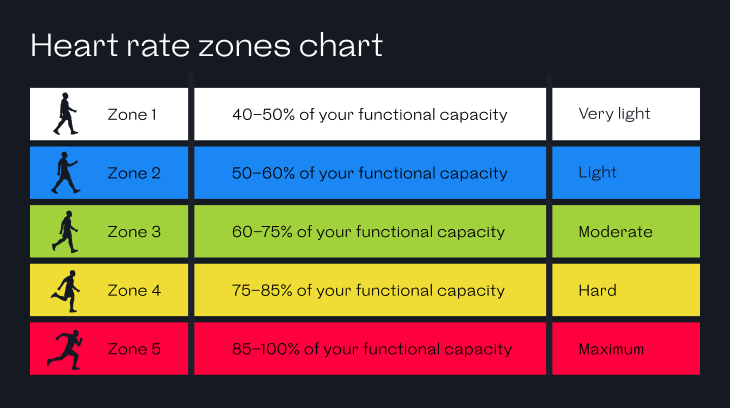First, let’s clarify a question: Why do we need to know our maximum heart rate (and resting heart rate)?
Many people monitor their heart rate during exercise and just want to know the current heart rate value to judge exercise intensity and physical condition. This is only part of the purpose of heart rate monitoring. The heart rate value is just a number, and its meaning is actually not that great. What’s more important is to know the heart rate zone level where your current value is, and compare it with the percentage of the maximum heart rate or reserve heart rate (reserve heart rate = maximum heart rate – resting heart rate).
For example, if a family car and a sports car reach the same speed of 180km/h on the highway, the former is already “doing its best”, while the latter still has room for speed increase. Similarly, most ordinary people and professional athletes will be out of breath at a heart rate of 170, but the latter can maintain this heart rate for a long time. Therefore, we need to know our maximum heart rate and resting heart rate, so that the current heart rate value will be more meaningful.
The formulas for calculating maximum heart rate range from simple to complex. The problem with calculating through formulas is that formulas are just averages summarized from samples by exercise physiology experts, and may not be so accurate for individuals.
If you really want to know your accurate maximum heart rate and you happen to have a suitable venue, you can try this actual measurement method——
The most ideal venue is a 400-meter slope with a slope >5°. If there is no slope, a standard 400-meter playground will suffice;
Before the test, jog for 10-15 minutes to warm up (about 2 kilometers) to prepare the body for exercise;
start testing:
For the first time, run a 400-meter slope with 80% effort (or 800 meters if it is a playground). After completion, jog downhill and rest for 3 minutes;
Run the same distance for the second time with 90% effort and still rest for 3 minutes;
Run the same distance with all your strength for the third time and rest for 5 minutes. Check your watch during the break. After the third run, you will get a maximum heart rate value, such as 190;
For the fourth time, I still ran with all my strength, and mentally wanted to “break through” the heart rate of 190, and still rested for 5 minutes.
If you run with a higher heart rate value for the fourth time, continue running with all your strength for the fifth time (which also means that you actually did not go all out for the third and fourth time)… until you can no longer run higher than before. up to the value.
The highest heart rate value in the penultimate run in the test is also the highest value in the entire test, which is your actual maximum heart rate.
Keep in mind that people with heart disease should not take the actual physical test of the maximum heart rate, and it is best to have others present during the test.
After talking about the maximum heart rate, I also mentioned the measurement of resting heart rate. Much simpler——
Choose a morning when you have enough sleep and a relatively regular life. After waking up, sit up and stay quiet for 1 minute. Record the value measured by the heart rate monitor after 1 minute. Average it over several days and it will be your resting heart rate. The resting heart rate of ordinary people is generally between 55-70, and the heart rate of top marathon runners and cyclists will be as low as below 50.
After knowing our maximum heart rate and resting heart rate, we can get our own heart rate zone by entering the maximum heart rate and resting heart rate during setting. Heart rate zones are composed of a series of intervals of heartbeats per minute, usually composed of 5 gradually increasing intervals numbered 1-5.
Different heart rate zones represent different exercise intensities. What we usually call the fat-burning zone/low-intensity aerobic zone/moderate-intensity aerobic exercise… is the zone where the heart rate is between 60-70% of the maximum heart rate during exercise, which is also the heart rate range for most people when jogging. On Garmin watches, this heart rate zone will be shown in blue.
Maximum heart rate and resting heart rate will change with lifestyle changes, age, exercise habits, etc. It is also recommended that everyone develop the habit of recording heart rate. If it is usually around 60, but today it reaches 75, you need to pay attention to whether you exercised too much yesterday, or if it is a sign of physical discomfort.




